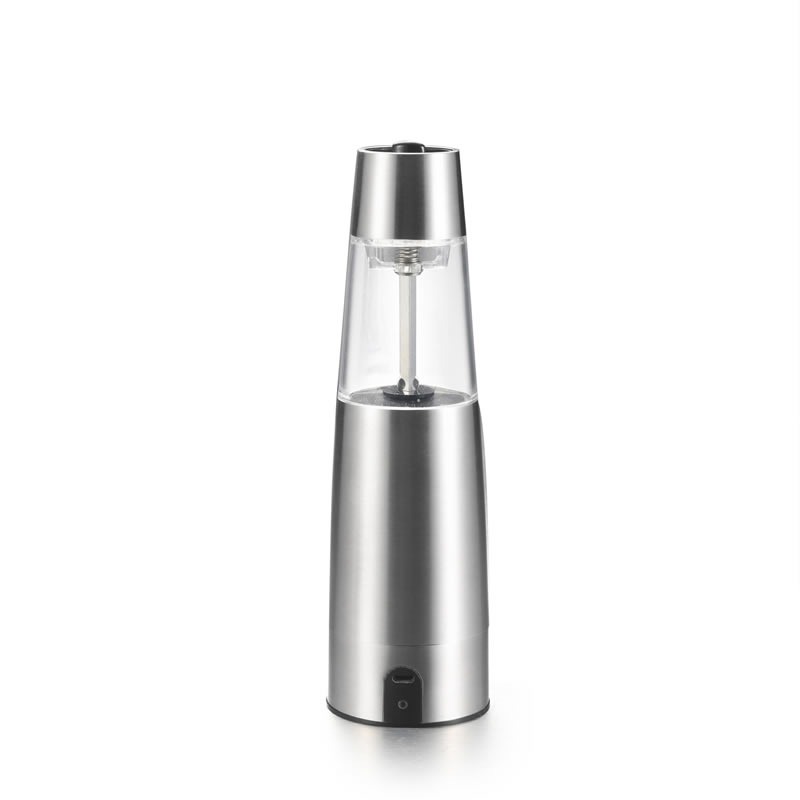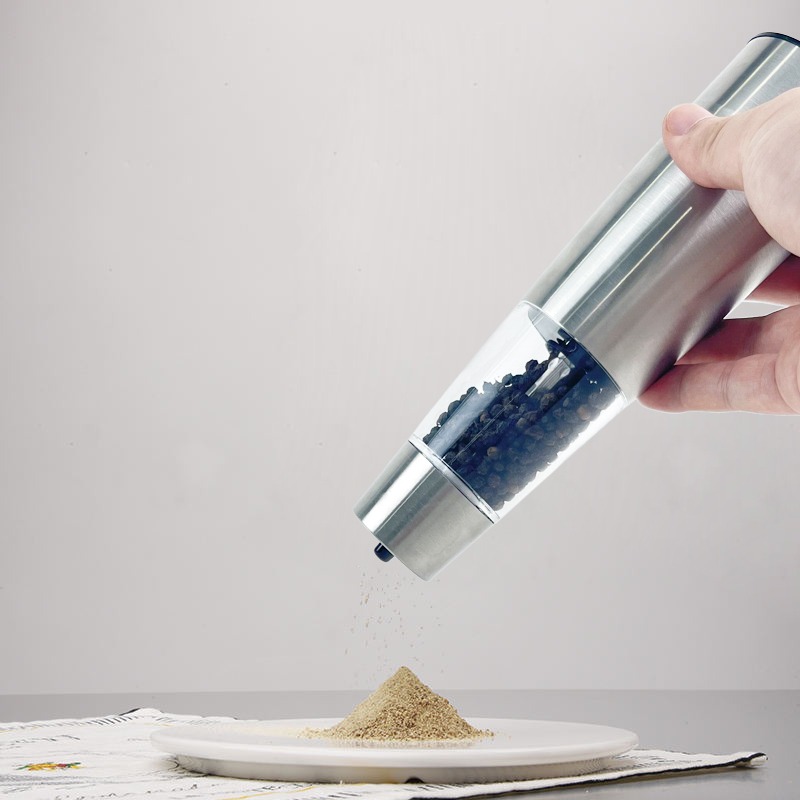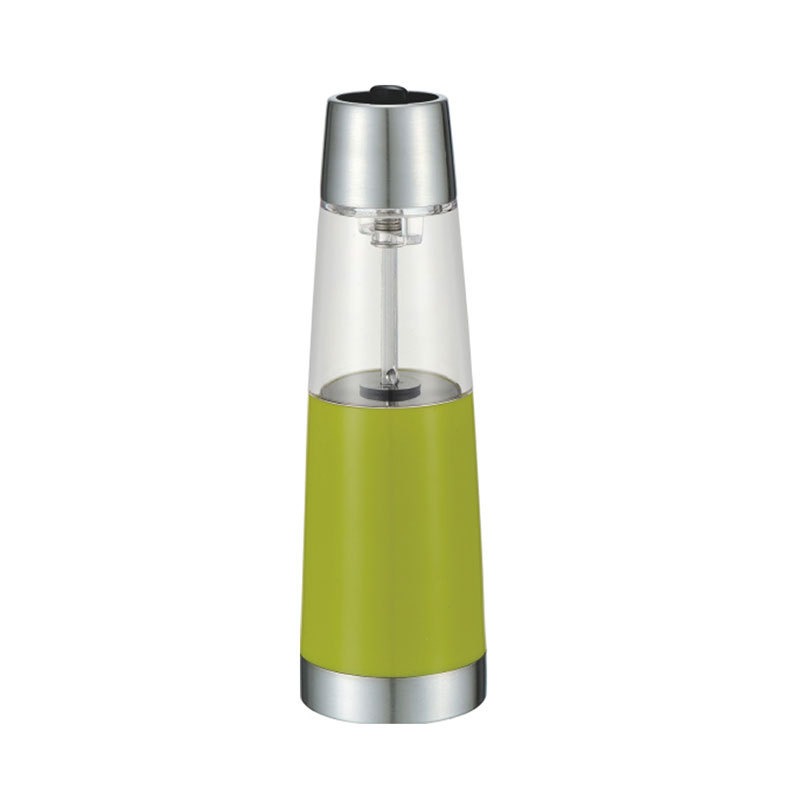Salt and pepper mills are excellent instruments for flavoring food using fresh ingredients. A pepper grinder can provide more flavor than pre-ground peppercorns, whether you prefer a thin dusting or a scattering of coarse peppercorns. Electric salt and pepper mills offer unparalleled convenience and simplicity, particularly for individuals with physical restrictions. In contrast, manual salt and pepper mills offer a traditional, hands-on method that allows complete control over the texture of your grind. So, which type of pepper mill—manual or electric—should you choose?
Introduction
A salt and pepper mill is necessary to flavor food with freshly ground spices. You may have to choose between manual and electric grinders. Every variety has particular advantages and disadvantages. This article will assist you in comparing the two to see which best fits your lifestyle and culinary demands by considering cost, durability, control, and convenience.

How to Do Manual Salt and Pepper Mills Work?
Manual salt and pepper mills are relatively straightforward devices for reducing the size of entire pees. Usually, these mills work with a simple mechanical mechanism that begins with loading the spices into a chamber at the top of the mill. Then, by twisting the top portion of the mill, the user crushes and grinds the spices against a stationary ring with teeth or grooves that match a rotor.
The grinding mechanism, the central part of these devices, is frequently constructed from sturdy materials like carbon steel, stainless steel, or ceramic. By turning a knob or screw at the mill’s base or top, the user can often modify this mechanism to select the final product’s coarseness, from fine powder to coarse pieces.
Manual mills run entirely on human labor; neither electricity nor batteries are needed. This makes them lightweight and convenient to use anywhere and gives food preparation a little participatory charm, elevating the seasoning process to a more intimate and exciting culinary experience.
How Do Electric Salt and Pepper Mills Work?
Electric salt and pepper mills automate the grinding process, making seasoning easier. These devices can be used continuously without requiring physical labor because they run on batteries or can be recharged. The primary mechanism consists of a battery-powered motor that turns a tiny gear. The peppercorns or salt crystals put into the mill are crushed and ground by a grinding mechanism turned by this gear.
The user must turn a switch or press a button to start the mill. This engages the motor, which then rotates the internal burrs, which are usually composed of stainless steel or ceramic. These electrically powered grinding parts are comparable to those found in manual mills. Many have an adjustable setting that lets users choose between fine and coarse, depending on their preferred coarseness. Usually, the mill has a dial or switch for this adjustment.
Electric mills are easy to use and efficient, making seasoning food simple and quick. Because they can be used with one hand, freeing up the other for other activities, they are accommodating when cooking or entertaining.

Detailed Comparison Between Manual and Electric Salt and Pepper Mills
Convenience and Ease of Use
Ease of Use: Electric mills are perfect for multitasking cooks and offer unmatched simplicity with straightforward push-button operations. Manual grinders are more labor-intensive, requiring some physical strength or motion in addition to using both hands.
Suitability for User Groups: Because electric models do not require manual grinding, they are especially advantageous for the elderly, people with arthritis and joint pain, or people with weak hands. While they may be less ideal for people with physical restrictions, manual grinders can provide a more fulfilling tactile experience for others.
Control Over Grind Size
Precision and Adjustability: Manual salt and pepper mills frequently offer better grind size adjustability, enabling fine control over the coarseness of the spices—a critical component for flavoring particular meals. Although they are more handy, electric grinders could be less precise and have fewer options.
Importance in Cooking: The ability to modify the size of the grind is crucial since different foods and recipes call for different spice textures to release their flavors to their fullest.
Durability and Maintenance
Robustness and Longevity: Manual mills or grinders don’t have any electrical parts that can fail or wear out, so they often have a longer lifespan than other grinders.
Maintenance Needs: Maintenance requirements are lower for manual mills because they usually need to be cleaned occasionally and don’t require a power source. Even though convenient, electric grinders require more cautious cleaning around electronic components and frequent battery changes or charging.
Cost Considerations
Initial Cost: Compared to electric devices with more complicated components, manual grinders are typically cheaper to set up first.
Long-term costs: Manual grinders don’t need batteries or energy, so they have meager long-term costs. Electric salt paper mills may require more frequent replacements, resulting in higher power consumption costs.
Portability and Noise
Portability: Because manual salt and pepper mills don’t need a power source, they are more portable and can be used on the go, at the table, or outside. Electric grinders are often only used in kitchens and are less portable.
Noise Levels: Manual grinders are quiet in operation, making them less bothersome in eating and kitchen environments. Because of their motor, electric grinders make more excellent noise when operating.
Environmental Impact
Environmental Footprint: Manual grinders don’t require batteries or electricity, so they have a lower environmental impact. For their lives, they are more resilient.
Consequences of Power Use: Electric grinders require electricity or replaceable batteries, but they add to the environmental burden of electronic waste and energy consumption concerns.
This comprehensive comparison outlines the main distinctions between manual and electric salt and pepper mills, offering helpful information to assist consumers in selecting the model that most closely matches their requirements, way of life, and environmental values.
Choosing the Right Salt and Pepper Mills for You
Whether it’s an electric or manual grinder, the best option for you will mostly rely on your culinary habits, lifestyle, and taste. When selecting your choice, keep the following essential considerations in mind:
Cooking Volume and Frequency: An electric grinder can help you quickly season food if you cook or entertain a lot. It also offers speed and ease. A hand grinder usually works well for smaller, more informal meals.
Personal Physical Condition: Since an electric grinder eliminates manual grinding, it’s a viable option for people with arthritis, joint pain, or restricted hand strength. If you don’t mind these things, seasoning using a manual grinder is more regulated and participatory.
Environmental Consciousness: Using a manual grinder is beneficial if reducing your influence on the environment is a top focus. It eliminates electronic waste and your carbon footprint because it doesn’t require electricity or batteries.
Practical and Aesthetic Preferences: Consider the grinder’s design and noise level during operation. Electric grinders are typically more modern but noisier than manual grinders, which are quieter and often more aesthetically adaptable, effortlessly integrating into a variety of kitchen decors.

Real-Life Applications and User Feedback (Salt and Pepper Mills )
Case Study
Manual Salt and Pepper Mills for Home Cooking: In a case study that favors conventional cooking techniques, a family finds that manual mills are better because of their tactile input and the control they provide over seasoning. They love the visual appeal and the hands-on experience that comes with grinding.
Electric Salt and Pepper Mills in Busy Restaurants: Another study examines how electric mills are used in a restaurant setting that moves quickly and demands efficiency. Employees appreciate operating electric mills with one hand, enabling them to work more productively during peak hours.
User Reviews and Ratings
Manual Mills: While some reviewers point out the labor involved as a disadvantage, others emphasize the human control over grind size and the mill’s longevity.
Electric Mills: Customers usually comment on how convenient and simple it is to operate, particularly for those with hand strength problems or arthritis. Critiques, however, typically center on the higher initial expenses and requirement for battery refills.
Final Thoughts
Lifestyle requirements, cooking habits, and personal choices influence the decision between manual and electric salt and pepper mills. With manual grinders, you can precisely regulate the grind size and improve the texture and flavor of your food while also enjoying a tactile and exciting experience. They are usually more enduring and eco-friendly because they don’t need batteries or electricity. However, because they only require one button to operate, electric grinders offer unparalleled convenience, making them perfect for anyone with weak hands or hectic kitchens where efficiency is crucial.
Every kind of grinder has advantages and disadvantages. Other criteria that impact your choice include how often you use it, how much food you usually season, and maintenance and cost considerations. A hand grinder can be the better option for people who value tradition and have the leisure to appreciate the procedure. On the other hand, an electric grinder might be the best option for people seeking speed and convenience, especially in a high-volume scenario.
The ideal grinder complements your cooking style, meets your unique demands and preferences, and blends smoothly with your daily routine.
FAQs: Salt and Pepper Mills
What is a salt and pepper mill?
Users can grind whole peppercorns and coarse salt into smaller, usable particles with a salt and pepper mill. Manual or electric mills allow adjustment of the grind’s fineness for individual preference. They enhance the flavor by providing freshly ground spices for cooking and seasoning at the table.
What material is used for pepper mills?
Manufacturers commonly make pepper mills from wood, stainless steel, ceramic, and plastic. Manufacturers commonly use hardened steel, ceramic, and carbon steel to construct the grinding mechanism, with each material offering different levels of durability and suitability for grinding peppercorns.
What is the advantage of a pepper mill?
A pepper mill offers the advantage of fresh flavor and aroma that pre-ground pepper lacks. It allows for adjustable grind settings, enabling the user to choose the coarseness of the pepper for different culinary applications. Additionally, it adds style and sophistication to kitchen tools and dining tables.
Can you use regular salt in an electric grinder?
You can use regular salt in an electric grinder, but it is best to ensure the salt is coarse. Refined table salt may cause the grinder to clog and damage the grinding mechanism if not designed for finer grains.
Are electric grinders better?
Whether electric grinders are better depends on the user’s needs. Electric grinders offer convenience and ease of use with the push of a button, making them ideal for those with limited manual dexterity or who need to season large amounts of food quickly. However, manual grinders provide more control over the grind and do not require batteries or electricity.






